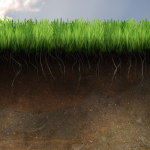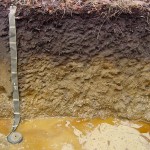Don’t forget the squirmies! When I was asked to write about soil quality for this blog I thought “wow, what a boring topic. Who wants to read this?”  Then I remembered a really great talk I heard this winter given by Joe Boggs and Jim Chatfield of Ohio State University. The take away message from this talk was “don’t forget the Squirmies!” Joe and Jim managed to completely engage the audience by using a humorous approach to a rather dull topic.
Then I remembered a really great talk I heard this winter given by Joe Boggs and Jim Chatfield of Ohio State University. The take away message from this talk was “don’t forget the Squirmies!” Joe and Jim managed to completely engage the audience by using a humorous approach to a rather dull topic.
 Sure, we all remember from botany and science classes that all soils are composed of three mineral particles: sand, silt, and clay. And they all have different cation exchange capacities, different pH values, water holding abilities, and different structures. The science of soils is very interesting, complex, and a little mind boggling to be honest. Entire education courses are devised to understand the biology, chemistry, and physics related to soil.
Sure, we all remember from botany and science classes that all soils are composed of three mineral particles: sand, silt, and clay. And they all have different cation exchange capacities, different pH values, water holding abilities, and different structures. The science of soils is very interesting, complex, and a little mind boggling to be honest. Entire education courses are devised to understand the biology, chemistry, and physics related to soil.
As gardeners, all we really need to know are a few basic rules: don’t compact the soil; don’t destroy the soil structure; and plant appropriate species for the type of soil you have. All good soils have excellent tilth: that is, a good combination of the three mineral particles (sand, silt, and clay), moisture holding abilities, aeration, and rate of water infiltration and drainage. All bad soils lack excellent tilth in one or more ways.
But what about the Squirmies? The Squirmies are all the things that artificial soil mixes don’t have. They are the things that make a virgin forest soil layer the best soil there is. They are the microbial glue that makes plants thrive, the things you can’t see. They are the nematodes, fungi, and micro-organisms; the biological aspects of soil. They stick to the soil particles and form the soil aggregate. They make the macro-pores in soil structure that allow water and oxygen passage. They are the real heroes of good soil.
Once soil structure is destroyed it can never return to its original state. But, don’t give up, all is not lost. We can do things to help it return to something close to what it once was. High quality organic compost is the single best soil amendment that you can apply to your soil. Good compost is teaming with the Squirmies and repeated applications will get the soil “growing” again. Have patience, this process takes time.
Other soil amendments are nitrogen, phosphorus, and potassium (NPK); sulfur; micro and macro-nutrients (such as manganese, boron, etc.); and others. To find out what your soil needs you should get a soil sample. Soil labs can show what essential elements might be missing. Once you know what your soil lacks you can begin to reconstruct it.
We use compost on all our planting jobs, sometimes we use it for mulch instead of shredded bark. Now, we are beginning to use a new product on the market called Holganix. It contains a slew of neat ingredients: compost tea, humic and fulvic acids, kelp, gluten, endo and ecto-mycorrhizae, nitrogen fixing bacteria, protozoa, nematodes, yucca extract, plant hormones, fungi, and micronutrients, among other things. Wow, Squirmies and then some!!
What makes a good soil bad? Us! We are the ones responsible for turning a good soil into a bad soil. We can begin to fix that problem with good horticultural practices and that includes the help of our new superheroes, The Squirmies!
